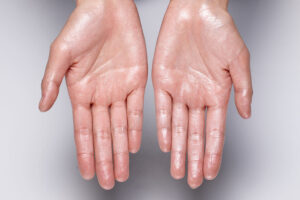Table of Contents
Sometimes your skin can act as an early detection system–warning you that something within your body is wrong. Such can be the case with sudden, excessive sweating and pale, clammy skin. When both symptoms occur together, it’s wise to take them seriously and put some effort into determining the cause.
15 Conditions That May Be the Underlying Cause of Your Pallor and Sweating
- 1. Influenza
- 2. Kidney Infections
- 3. Anemia
- 4. Heat Exhaustion
- 5. Alcohol or Drug Withdrawal
- 6. Cancer
- 7. Chronic Infections
- 8. Venomous or Severe Bites
- 9. Arterial Blockage
- 10. Diabetes
- 11. Heart Conditions
- 12. Hypoglycemia
- 13. Thyroid Problems
- 14. Anxiety
- 15. Medications
Sometimes, heavy sweating and pallor appear together as a reaction or sensitivity to something as benign as an anxiety attack or feeling of panic. Even though these are serious and stressful emotional states, they don’t necessarily point to an underlying dangerous clinical health issue. In other situations, however, severe pallor and sweating are signs of a more serious medical condition.
What is Pallor?
The term “pallor” refers to the unnatural pale color of someone’s skin. If someone is paler than normal, that person can be described as having a pallor, or abnormal absence of color on the outer layer of the skin. Pallor can also include paleness inside the mouth, in the linings of the eyes, and on the surface of the tongue.
This kind of pale skin has nothing to do with the amount of melanin in it–this is more than simply a pale complexion. Instead, this kind of skin pallor is driven by the thickness and density of blood vessels that sit beneath the skin. Often caused by a lack of blood flow to the skin, pallor can mean that someone is seriously ill, especially if it is accompanied by sudden and inexplicable excessive sweating–also called diaphoresis or secondary generalized hyperhidrosis.
For people with naturally darker skin tones, skin pallor may only be detected by a clinical assessment of the mucous membranes. Pallor is usually most visible in the face and the palms of the hands. Depending on its root cause, pallor can develop gradually over time or appear quite suddenly. When a waxen pallor appears suddenly and unexpectedly, it may be a sign of a more significant health issue.
However, unless skin pallor also is accompanied by paleness of the tongue or inside of the mouth, pale lips, palms or lining of eyelids, it is likely not a serious condition that requires medical diagnosis and treatment.
Why Does Excessive Sweat Sometimes Accompany Pallor?
Quite often, very pale skin is bathed in a layer of cold and clammy sweat on the face, hands, or body. Under normal conditions, this is the body’s natural method of cooling down the body’s temperature by creating sweat that then evaporates on the surface of the skin. The system works best in response to high temperatures or physical exertion.
However, diaphoresis–which is the type of sweating that often accompanies extreme pallor–is a little different. It sets in suddenly and may seem inexplicable until you understand the root cause. In other words, it’s not a normal reaction to heat or physical exertion.
If pallor causes are related to an emotional stressor like anxiety or fear, it’s very common for pale skin color to come with some extra sweat. In addition, other underlying medical conditions, including some medications, can signal your sweat glands to kick into overdrive in tandem with facial pallor.
15 Conditions That May Be the Underlying Cause of Your Pallor and Sweating
Many different health issues can lead to skin pallor and sweating. Here are some of the most common underlying causes of pallor and sweating.
1. Influenza
Influenza is just one of many types of infections that can lead to a high fever. Common in adults and children, this illness is often accompanied by a pale face and clammy skin. Because influenza is caused by a virus, it must simply run its course, at which time the pale color and sweating should subside.
2. Kidney Infections
Depending on the cause of the infection, antibiotics may be of some help. If a bacterial infection can be cleared up with antibiotics, the associated pale skin and sheen of sweat should dissipate. Further complications can arise, however, when an infection leads to chronic kidney failure, which is associated with anemia, another cause of pale skin and clamminess.
3. Anemia
People diagnosed with anemia don’t produce enough red blood cells, and this condition is one of the most common causes of skin pallor. Because its root is a lack of red blood cells, anemia can lead to pale skin, dizziness, fatigue, headache, and more. This disease can develop suddenly and acutely or more slowly over time. Chronic anemia is the most common–with this condition, the body can’t sustain a sufficient hemoglobin level, which is the protein in red blood cells that carries oxygen. When seeking a diagnosis, physicians will often examine the eyelid, as pallor of the inner eyelids is a sign of anemia.
4. Heat Exhaustion
Heat exhaustion is known to cause symptoms of pale, cool and moist skin, muscle cramps and abdominal pain, intense thirst, heavy sweating, and more. Once heat exhaustion is addressed, the facial pallor and sweating will likely subside.
5. Alcohol or Drug Withdrawal
Often, as a patient goes through the process of withdrawing from drug or alcohol use, the body responds with several symptoms, including sweating profusely and draining color from the skin.
6. Cancer
Some cancers, including colon cancer, renal cell cancer, and multiple myeloma, have been linked to skin pallor. At times, these conditions are also complicated by the fact that they are treated with powerful medications, which, on their own, can also lead to blanching of the skin and a cold, clammy sheen. In addition, at least one clinical study shows a connection between anemia pallor and cancer, whether naturally occurring or induced by the regimen of medications for cancer treatment.
7. Chronic Infections
As with other infections, the root cause of the illness is key. Viral infections will have to naturally run their course, while bacterial infections can be cleared up with antibiotics. Once the underlying infection is remedied, the symptomatic pallor and diaphoresis should cease.
8. Venomous or Severe Bites
Sometimes, an animal or insect bite can lead to symptoms of skin pallor and excessive sweating. This caused by the pain and shock, and the possible presence of venom. Some bites also carry with them the risk of anaphylaxis, which is an extreme allergic reaction that can be life-threatening.
9. Arterial Blockage
A lack of blood circulation due to an arterial blockage often can cause localized pallor–usually in the arms or legs. The limb may also become cold and painful as a result of the lack of circulation.
10. Diabetes
This disease often puts people at higher risk of dangerously low blood sugar, or hypoglycemia, which not only causes pale skin but is also accompanied by profuse sweating.
11. Heart Conditions
Heart issues ranging from heart disease, heart infection, a heart attack, or heart failure can often lead to cold, clammy and pale skin. Such symptoms also can stem from structural abnormalities or damage of the heart, which can be confirmed through diagnostic tests. If pallor and sweating are accompanied by chest pain, shortness of breath, nausea or pain in the back, neck, jaw or arm, you should contact emergency health care immediately.
12. Hypoglycemia
Hypoglycemia, or low blood sugar, is known for causing symptoms ranging from clammy skin and anxiety to shakiness and irritability. It can be a dangerous condition, particularly among children, if not treated quickly and is often most associated with those who have diabetes. In addition, hypoglycemia is often a side effect of some medications used to treat diabetes.
13. Thyroid Problems
An overactive thyroid can also raise a person’s metabolism, which can lead to the excessive sweating that often accompanies thyroid-related skin pallor. In particular, a thyroid storm–a dangerously high thyroid hormone level–can cause racing heartbeat, sweating, pallor, and fever. A simple diagnostic test can let you know if your thyroid is causing your issues.
14. Anxiety
You may have heard the phrase, “pale as a ghost” to describe someone’s response to a fear-inducing event. Sometimes pallor can signal a reaction to extreme emotional changes–positive and negative. Anxiety can also lead to panic attacks, causing a sudden, intense fear that can’t be controlled. Panic attacks are extremely stressful, as they mimic serious physical health conditions–including causing pale, clammy skin and nervous sweating. Anxiety, however, can be effectively treated through both counseling and appropriate medication, which should cause accompanying symptoms to subside.
15. Medications
Your medication is often the most common cause of skin pallor and sudden sweating. If a medication causes a side effect, such as vomiting, skin pallor can follow. If you detect pale skin and diaphoresis and you know you’ve recently started a new medication, it’s worth talking with your primary care physician about your medicine. Medications that can cause sweating and pallor include painkillers, some cancer medications, blood pressure and heart medicines, and some gastrointestinal medications.
Skin Pallor and Sweating
The causes of skin pallor and sweating are many and varied – and the list presented here is not meant to be exhaustive. The bottom line is that if you are experiencing skin pallor and diaphoresis, especially if accompanied by other, more severe, symptoms like fainting, vomiting, fever or trouble breathing, you should talk with your primary care physician immediately. Your doctor likely will review your medical history and symptoms, give you a physical examination and test vital signs like blood pressure and heart rate. Depending on the amount of melanin in your skin, he or she may also check your inner eyelids. Your doctor may also order additional tests for clinical diagnosis – like a vitamin deficit scan, abdominal X-ray, extremity arteriography or complete blood count test.
Treatment may range from simple diet changes to taking iron supplements, starting a round of medications to treat an ongoing, underlying medical condition or even surgery. This last option is typically reserved for severe cases where someone has lost a large amount of blood – necessitating a blood transfusion be performed – or when an arterial blockage must be removed.
Ultimately, many causes of skin pallor and sudden, excessive sweating are highly treatable and non-life-threatening. But it’s key to understand an accurate clinical diagnosis about what is causing your skin pallor and diaphoresis. Various conditions, including infections, anxiety, hypoglycemia and more can be effectively managed through a combination of medications, lifestyle changes, and behavioral therapy. When pale, clammy skin is the result of an emergency health issue, as long as medical and surgical treatment is administered early, it’s possible to make a full recovery from the underlying issue.
You might also like...

What is Focal Hyperhidrosis? Symptoms, Treatments, & Tips for Managing It Successfully
Table of Contents Does excessive sweating bother you? Keep you from being social? Or make you feel like you can’t

What is Diaphoresis? Sweating as a Medical Side Effect
What Is Diaphoresis? Sweating As a Medical Side Effect Table of Contents Are you sweating profusely for no apparent reason?

How to Stop Sweating So Much? 9 Tips to Beat Unwanted Sweat
If you’ve ever suffered through an awkward sweaty hug, a slippery handshake, or a sweat-soaked job interview — this article
















